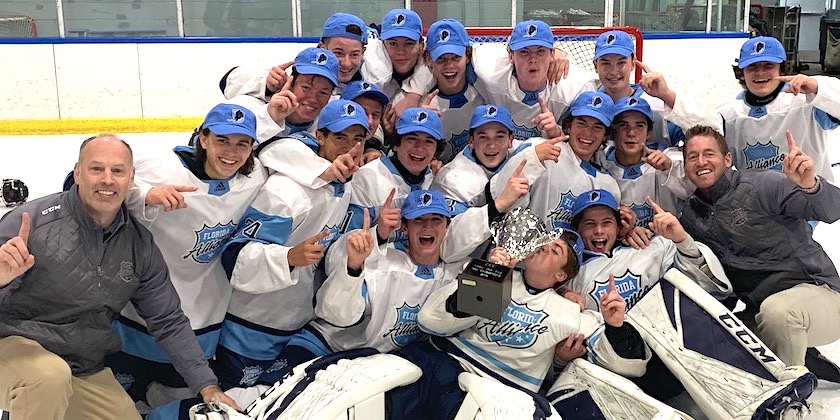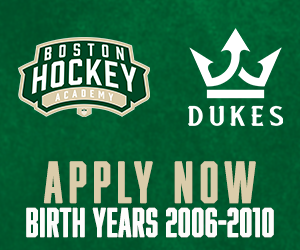When it comes to skill development at the Tier I level, no one is doing it like Ryan Brindley, Steve Dubinsky and the Florida Alliance.
The Alliance won the 16U Red Division of the 2019 ECC Labor Day Cup earlier this month, beating out the field with a roster that was filled with seven 2004-born players, competing against players a year older than them.
But perhaps what’s even more notable is their approach to their program and, and how they are developing Division I talent in a non-traditional hockey state.
How do they develop that skill? Brindley says it’s simple. Skill development is the biggest focus of their program.
“We’ve had a bunch of guys come through here, NHL guys, who have helped coach and had their kids here,” Brindley said. “Brian Rafalski was down here for a couple of years, and he helped me coach, and there has been a lot of different guys. A lot of ex-NHL players.
“We are huge on development. We work closely with USA Hockey. We have the philosophy that, in order to train and develop, you don’t need to play all these games. It’s tough in Florida, but we should be limiting the travel as best we can.”
The Alliance use a weekend model. With the exception of clinics around the state during the week, almost all of their training is done on the weekends. It allows players to play other sports — something Brindley is big on – during the week and it also allows for the program’s out-of-state players to go to school at home during the week, and then travel to Florida for hockey training on the weekends.
“It doesn’t matter that they’re not on the ice, they are developing skills,” Brindley said. “We run a lot of clinics and academies all over the state, because our players are coming from all over the state. Some teams might practice more, but it’s very hard in a team practice to work on skill-specific stuff. That’s the whole key to development, though. Working on skills.
“There are other programs out there that are starting to use our weekend model. Brian Rafalksi moved back to Wisconsin, and he has a model that is a lot like ours.”
Brindley’s son, Gavin, played volleyball for his school team. Others play soccer, Brindley said. The day Brindley spoke to Neutral Zone, he was about to hit the golf course with his son.
The model has attracted players from around the country. The 16U team has players from Chicago, Pittsburgh and Maryland. And with the weekend model, they don’t have to relocate to Florida. Brindley said they train at home during the week — some with local USHL teams and others with skills coaches — and then travel to Florida on training weekends to focus on hockey.
One of the biggest advantages to the model is more time for players to develop strength with off-ice training, especially in the weight room. At high levels of amateur hockey, players are typically maintaining their strength during the year because it becomes difficult to add to it with the numbers of games that are required.
But with the Alliance, players can focus on building strength throughout the week. Fewer games also mean less wear and tear on the players throughout the season.
The added focus on strength building is part of the reason why Brindley’s 2004’s stood out, even against older players.
“We’re going to be around 52 games this year, which is more than I’d like to be honest, but it’s a fair number,” Brindley said. “The thing we do fight is the travel. It’s Florida, so it’s something we have to do.”
Brindley played college hockey at Miami and then embarked on a professional career that took him to multiple organizations in the AHL and ECHL; he settled with the Florida Everblades in 2004 and captained the team in 2006-07, his final pro season.
Now, he lives across the street from the rink.
Dubinsky, a Clarkson grad, played 375 NHL games over his career, mostly with the Chicago Blackhawks.
“It’s not really a business for us,” Brindley said. “We’re basically volunteer coaches. Most of us all have kids on the team. It’s hard because it’s so competitive. Different sports are competing for the same kids and they all want them year-round. But for us, it’s a development model and not a business model, so I love it if one of my kids wants to play something else during the week.
“The best way I can describe it is that we have a development model, and not a business model. There’s a big difference.”
Word is starting to spread about the success the Alliance have had winning tournaments and developing players. Brindley said last week that he recently spoke to a Division I head coach who wanted to potentially move his son to Florida to play for the Alliance next season.
Gavin Brindley and Seamus Casey, two Alliance players, are on the shortlist of most scouts when looking at potential players who have a strong chance to make the U.S. NTDP.
The schedule is full for the days the team is training. Players train two out of every three weekends, for the most part. There will be longer breaks around Christmas and then before nationals.
They’ll arrive on Friday — out-of-state players might arrive on Thursday — and the players hit the ice for a 90-minute session. Multiple coaches are on the ice, and they’re all working on a dedicated skill. Goalie coaches are with the goaltenders while Brindley runs power skating and other coaches have their specific focus.
After the on-ice session, players meet with Greg Poss, the former head coach of the Everblades (and EC Red Bull Salzburg) who has a brain science program designed specifically for athletes.
“That’s a huge part of what we do,” Brindley said. “That differentiates us.”
From there, players have a team meal at the Brindley house on Friday night and then players from out of town pair up with the five local families to spend the night.
Saturday the team is on the ice for three hours, with video sessions mixed in and another team meal on Saturday night.
Before players leave on Sunday, they’re up for an early-morning on-ice session — about two hours — and then 90 minutes of yoga.
Players from out of state then hop back on planes and are back in school on Monday morning.
“I think when you are focusing on skill development the way we are, the rest of it takes care of itself,” Brindley said. “You’ll win games because you have good, skilled players. We had a lot of kids we were competing against that left Florida for the Avs, or Mount St. Charles. It was fun competing against those guys. We’d like to keep them all in Florida through their 16-year-old year, but everybody has their own path. This one just works for us.”





